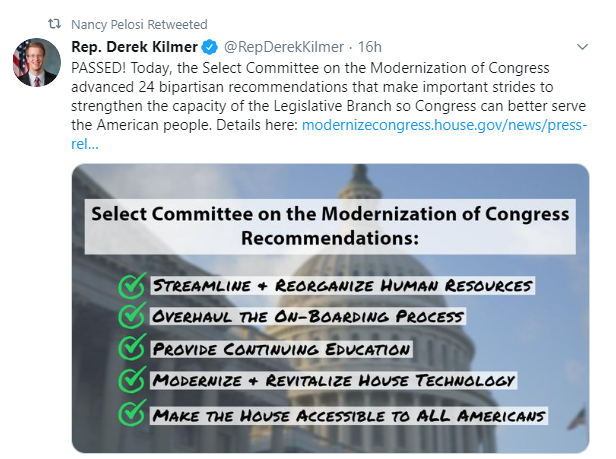Right before heading out for August recess, the Modernization Committee hit another milestone: passing its second set of recommendations! It’s no secret that Congress is behind the times when it comes to technology and processes, and these 24 proposals are critical to bringing the institution into the 21st Century. Not only would they improve Congress’s outdated technology, they also focus on two areas key to making government work better for the American people: recruiting, developing, and retaining a highly-skilled congressional workforce; and reinforcing bipartisanship in training and orientation.
To serve the country better, lawmakers must have effective tools and a functional work environment. Yet, many members of Congress face basic barriers to providing the best service to their constituents and making a substantive impact. For new members in particular, the process of setting up congressional and district offices while balancing a busy orientation process detracts from their ability to legislate when they first take office. Additionally, the lack of an effective centralized personnel office to support lawmakers and their staff only makes the process more cumbersome. These proposals work to address these challenges.
As science, technology, and data capabilities evolve, Congress must be able to rapidly receive timely, high-quality, non-partisan information in order to guide its policy decisions. Since the dis-appropriation of the Office of Technology Assessment (OTA) 24 years ago, Congress has lacked the necessary understanding and resources to address critical technological issues that will shape our nation’s future. Among the committee’s recommendations is reviving and restructuring OTA, which would give Congress the understanding it needs to make informed decisions and bolster congressional commitment to evidence-based policymaking.
Check out what members of Congress, including House leadership, are saying about these recommendations!



To have a Congress that works, Congress must be equipped with 21st technology and processes for members and staff. By streamlining House human resources, revitalizing the member onboarding process and allowing continued education for members, and modernizing House technology, we’re one step closer to a Congress that works. Now it’s time for leadership and the House as a whole to act on these recommendations!
ICYMI, here’s what was included in the committee’s first set of recommendations to make Congress more transparent.